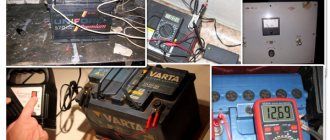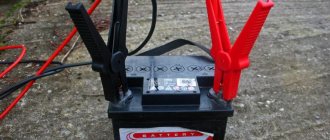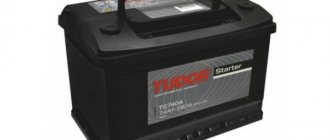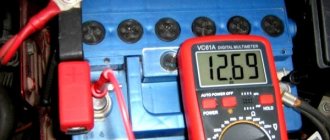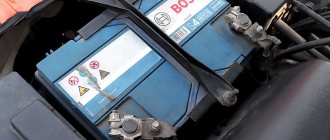The main nuances of charging a 60 Ah battery. Battery options, and the time required for a full charge. How to charge correctly.
TEST:
To understand whether you have sufficient information about batteries and how to recharge them:
- How many types of batteries are there?
a) There are two types of batteries - serviceable and non-serviceable. They differ in their tightness. The second option cannot be opened.
b) There is one battery option - serviceable. It must be disassembled to fill with distilled water.
- What voltage should be on the battery?
a) The voltage is 12 Volts when fully charged. Lower values mean the charge is being lost. The voltage will not rise above 12 Volts.
b) Many motorists believe that the voltage is 12 Volts. But this assumption is wrong. The optimal indicator is 12.6-12.7 Volts. This indicates that the battery is 100% charged.
- Is it necessary to carry out preparatory measures before cleaning the battery?
a) Before charging, the battery will need to be removed from the vehicle and cleaned thoroughly. Dirt will have to be removed as thoroughly as possible with a solution of water and soda. A rag is soaked in the solution and used to clean the contacts and the entire case.
b) No preparatory work is required. The device is connected and charging begins.
- Why should you be concerned about low electrolyte levels inside the battery?
a) If you do not add electrolyte, the battery will fail - the lead plates will become covered with growths.
b) If you do not change the electrolyte, the battery will fail - the lead plates will overheat and crumble.
- What charging values will the battery receive in the first 4 hours of charging?
a) In 1 hour of charging, the battery absorbs 50-60% of the nominal capacity. In the 2nd hour, the voltage drops - 15-20%. At the 3rd hour the figure will decrease to 8%. In the fourth, the battery capacity will be 90-96%.
b) In the first hour 20% of the rated power. In the second - 40%. In the third - 20%. In the fourth - 20%.
Answers:
- a) There are two types of batteries. 1 - serviceable, with opening lids for refilling. 2 - maintenance-free. The second option is completely sealed.
- b) The voltage should be 12.6-12.7 Volts. In this case, the charge level will be one hundred percent.
- a) Before charging the battery, it is advisable to rinse thoroughly and clean the contacts.
- b) If you do not add electrolyte, the lead plates will overheat and, as a result, crumble.
- a) In the 1st hour 50 - 60%. 2nd – 15-20%. In the 3rd - 8%. In the 4th, the full capacity will be 90-96%. It is important to know how to properly recharge your car’s battery. Modern devices can last up to 5 years if used correctly. The lifespan is reduced if the charging time for the battery is incorrectly selected. That is why it is necessary to know all the nuances of charging.
Definition:
A car battery is an electrical device that serves as a source of electricity for the car's network.
Operating principle of 60 Ah battery
Before you start charging, you need to make sure that the motorist knows how the battery works. Only there will it be possible to use it correctly.
Amp and hours. Battery capacity is measured only in amperes/hour. This means that a 60Ah battery will deliver 60A in one hour. If the load drops to approximately 30 Amperes, then it will supply for 2 hours and so on.
Voltage. Many people mistakenly believe that the voltage should be 12 Volts. But this is not entirely true. The optimal value is 12.6-12.7 Volts . This indicator means 100% charge.
We can conclude that 12 Volts is a battery with a charge level reduced by 40 or 50%.
But with this indicator the car will drive. If the car is fully operational and the generator recharges it, the voltage will soon reach the required value. If the battery shows 11.5-11.6 Volts, then the charger is deeply discharged. At this point, the lead plates will begin to sulfate and the machine will not start.
Auto battery structure
How do you know when to complete the battery charging process?
How long does it take to charge a car battery before the lost power is fully replenished? How to determine the end of a process? If you have a typical lead-acid battery, then the signal to complete charging is:
- for a serviced battery – stability of electrolyte density for several hours;
- for maintenance-free - a constant voltage value at the terminals for two or more hours.
If we are charging a calcium battery, then the criterion for its completion will be the absence of gaps in the charging process; the procedure will turn into a continuous pause.
How long does it take to charge a car AGM battery? Until the moment when the voltage value, constant throughout the charging process, begins to increase.
It is also important to know 2 nuances about the structure of the battery
It is also necessary to understand the structure of the battery, since the 2 modifications will have to be charged in different ways.
- The first option is maintenance-free batteries. Electrolyte is poured inside. Afterwards the battery is sealed from the outside. It will not be able to evaporate the substance inside. This option is the most optimal, since you don’t need to worry about constantly checking the level of the substance.
- The second type of battery is becoming a thing of the past and is serviceable. The battery does not have a sealed case, and therefore the electrolyte will evaporate over time. This reduces the charge level. This is a very problematic battery option, so you need to know how to properly charge and care for it. If the charge level drops, you must recharge immediately. But for this you need to prepare.
What current should I use to charge a 60, 70, 100 Ah car battery?
A small, inconspicuous-looking box installed under the hood turns out to be an indispensable source of energy. It ensures the operation of all on-board systems of the vehicle when parked and provides energy to the starter to start the engine. Our hero is the battery. But he himself sometimes needs support. All batteries must be charged periodically.
How to avoid 4 mistakes when preparing to charge
Before you start charging, you must properly prepare the battery. If it is disconnected from the car, immediately carry out a full inspection to avoid troubles during operation.
- The first step is to remove condensation, all dirt and oxide. You need to get rid of all this - wipe the contacts and the entire surface of the battery.
- For this purpose, they usually use an ordinary cloth, which is moistened in a soda solution. We wipe her contacts. As a result, we achieve cleanliness, and this is very important for the proper functioning of the battery. If the battery has a screw-on cap, then when dismantling it, dirt may get into it. This should be avoided, otherwise the battery will fail due to the banks being shorted.
- Unscrew the covers. We check that the electrolyte level is at the required level. If it is not enough, then you will need to add distilled water. The level is checked by the plates. If the solution does not cover them, then topping up is necessary. If you do not replace the electrolyte, the battery will soon stop working. The lead plates will overheat and, as a result, simply crumble.
- Check the density of the electrolyte. For normal functioning it should be 1.26-1.30 grams per cubic centimeter.
This was all the necessary preparatory work. After they are carried out, we proceed to direct charging.
It should be noted that several options can be used. Charging occurs using constant current and the same voltage. Depending on the choice of charging, the time will differ based on the parameters. This is worth thinking about if you don’t have a universal battery charger at home. The universal charger has a minimum of settings, and therefore it is very convenient.
Gel batteries and features of their charging
The problem with acid batteries has always been boiling, leaking, splashing and changing the composition of the electrolyte. The engineers worked hard and solved these problems. As a result of experiments, gel batteries appeared. These are still the same acid batteries, but filled with gel-like electrolyte. The gel does not splash, does not boil, retains its properties for a long time and has better contact with lead plates.
Batteries with gel electrolyte have a number of advantages:
- In case of minor damage to the case, the gel does not flow out
- The battery can be installed vertically or in an inclined position
- Safety of use (gases are not released when charging)
- Stable performance until the charge level drops to 70%
- Stated charge-discharge capability up to 1000 cycles
- Excellent performance at sub-zero temperatures
There are few disadvantages and they are conditional. These are requirements for the quality of the voltage of the on-board network and charger, and high cost. These shortcomings are more than compensated for by excellent performance properties.
Gel batteries can only be charged with modern pulse chargers. But for them there are two conditions: mandatory voltage control and stable current. The voltage is usually indicated on the case or in the battery instructions. This may be the inscription in English “Cycle use”. The charging current, as for all batteries, is 10% of the battery capacity.
Charging with a pulse device does not require any knowledge or skills from the user. You need to connect it to the battery, turn it on and set the required voltage. The device will do the rest itself. When the charge reaches 100%, the device will signal this.
The nuances of charging A K B 60 Ah with direct current
Look at the pictures for the nuances of battery charging.
Connection
It all starts very simply - we connect the negative side of the charger to the negative side of the battery. We do the same with the “pluses”. Many people use this option, since the amperage supplied to the battery is a very important parameter. It is prohibited to exceed or underestimate it. If it is underestimated, the battery will take a very long time to charge. And this is extremely inconvenient for the motorist.
It is always necessary to ensure that the voltage exceeds the nominal value. This means that you need to get approximately 13.8-14 volts from the charger. This is exactly the amount a car generator should produce. If the value turns out to be less than 12 or even 11 Volts, then nothing will happen, and the charge will be consumed even more. The optimal voltage is 10% of the capacity of the entire battery. This means that if there are 60 amperes per hour, then the current required is 6 A.
Correct battery charging. We look at the readings and useful tips when charging
If the device's charge has reached zero, you will need to prepare for long-term charging. It should be approximately 10 hours. But this time is sometimes reduced, depending on the charge level. If a serviceable battery is used, the charge level is very easy to determine. When bubbles begin to rise from the surface layer of electrolyte, this means that charging is 100% ready.
2 A
If you want to simply recharge the battery, then use the old proven method: set a current of 2A to 60 amperes per hour for the whole night. As a result, the battery will acquire the required amount of energy. This current is very small, but it is quite enough to recharge a not deeply discharged battery. If you want to feed the battery with a voltage at the contacts of 12 Volts, then set the current to 1 and 2 A at night. As a result, the battery will be well charged.
Accelerated battery charging
This method of charging the battery is used in cases where you need to quickly restore capacity for at least one engine start. For this purpose, many modern chargers have a Boost mode. When this mode is turned on, an increased current value is given when charging. In this case, the charging time of the car battery required to start the engine is about 20 minutes.
If your charger does not have such a mode, but it is possible to adjust the current, then you can set the increased value yourself. But do not set the current value more than 30% of the normal charging current. That is, with normal charging at 4 amperes, do not set the current to more than 5.5 amperes. This negatively affects the condition of the battery plates.
Accelerated charging should only be used in emergency situations, when you urgently need to start the car. After the trip, we recommend that you fully charge the battery as usual.
Charging time 60 Ah constant voltage
This option has recently become very popular, since the principle of its operation is implemented on Chinese units. In most cases, they do not have Voltage and Amperage indicators. The device contains only a few flashing dots and a scale that shows the battery charge level. Typically, this device is used for maintenance-free batteries, since it is not possible to see the boiling level of the electrolyte due to the impenetrability of the device. This is why the first option is not the best. Here you can automatically adjust the voltage and amperage.
The voltage fluctuates between 13.8-14.5 Volts. Accordingly, the higher the voltage, the sooner the battery will receive the required charge. In 1 hour of current treatment, the battery absorbs approximately 50 or even 60% of its rated capacity. That is, if it is 60 amps, then 60x60% equals 36 amps. In the 2nd hour the value decreases, and the charge will occur much more slowly - 15-20%. In the third hour, this figure will drop to about 8%. In the fourth, the full capacity will be 90-96%.
The subsequent hours are not so important since the current will drop to 0.2 amperes. To charge the battery to 100%, the same 10 hours of charge will be required. This option is very convenient because there is no need to configure the equipment. It does everything for a person.
Tips for Newbies
There are fully automatic chargers that do not require any knowledge from the user at all. Just so as not to confuse the polarity of the connected wires. But if you need to do the job efficiently, it is still advisable to know and understand something.
Features of charging maintenance-free batteries
Maintenance-free batteries in sealed cases should not be subjected to long-term charging with high current, this can lead to deformation of the case.
They may sometimes require some excess charging voltage, up to 16 Volts, but the current should not go beyond the permissible limits. And if the current begins to drop and the voltage rises, exceeding the specified limit, then the battery has taken as much energy as it can.
You must understand that the declared capacity coincides with the actual one only for a new battery, and during operation it evenly drops, sometimes significantly if operating conditions have been violated.
What is fast charging
Accelerated charging is considered to be double the current, that is, about 20% of the declared capacity. This mode shortens the battery life, so you can use it only for a short time, no more than half an hour, and do not allow the electrolyte temperature to rise above 50 degrees.
Charging time at 60 Ah
Charging time is selected individually depending on the device being used. First you need to understand whether the battery is completely discharged or not.
If we exaggerate and imagine that the battery has completely lost its charge, and there is a current strength of 10% of the nominal value, then it will take 10 hours to fully charge the battery.
If the voltage is adjustable, then we use 4-5 hours for a 90% charge and 8 hours are required for a 100% charge.
All values are at maximum discharge. If the battery is only partially discharged, then the time must be adjusted.
Application of the calculation formula
Charging should be accompanied by periodic checking of the process so as not to miss the moment when boiling begins. If the voltage at the battery terminals does not change during charging within 60 minutes, the process is completed.
The parameters of the final voltage directly depend on temperature, charging current, battery resistance, composition of the grid alloy, and the presence of impurities in the electrolyte.

